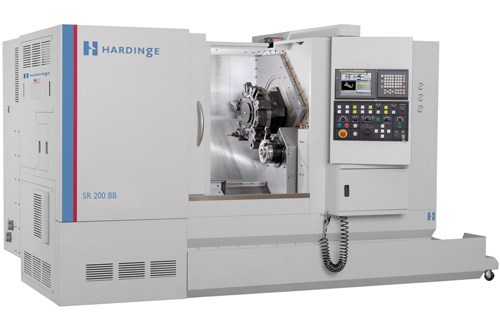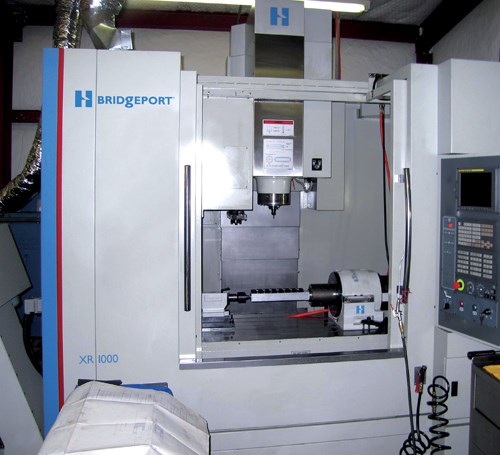Direct Drive Rotary System Reduces Cycle Time
In the early 1990s, Mr. Langlois decided to set up a shop specializing in close-tolerance aerospace parts. A friend of his recommended that he consider a colleted-spindle turning machine and suggested that he look into Hardinge lathes. Mr. Langlois purchased a used Hardinge HNC lathe and began making aircraft landing gear bushings.
Mike Langlois, owner of Aero Precision Machine (Julian, North Carolina), owned and operated his first lathe when he was 13 years old. He made his own model airplane parts to keep the motors running at higher horsepower and rpm, and even sold them internationally to other model airplane enthusiasts. He eventually earned a pilot’s license and bought an early model Beechcraft.
In the early 1990s, Mr. Langlois decided to set up a shop specializing in close-tolerance aerospace parts. A friend of his recommended that he consider a colleted-spindle turning machine and suggested that he look into Hardinge lathes. Mr. Langlois purchased a used Hardinge HNC lathe and began making aircraft landing gear bushings. His wife and two sons joined the business in 1996, and since then the company has grown to ten employees with about 8,000 square feet of shop space. Aero Precision Machine now produces parts for the aerospace, defense and pharmaceutical industries.
The company handles mostly small parts. Although diameters can be as large as 10 inches, the company’s specialty is the ¾- to 2 ½-inch range. Through the years, it has built its entire turning capabilities using Hardinge collet-ready spindle lathes for high precision turning.
"It’s all about accuracy," Mr. Langlois explains. "We made the decision to be a collet shop. Down here, that is kind of a rarity. Everybody wants to use an 8-inch chuck machine. Our parts are often more fragile, have a thin wall or a close tolerance." Typically with aircraft parts such as landing gear bushings, the shop’s machines need to hold a 0.0002-inch to 0.0003-inch tolerance on the OD and ID.
Early on, company management decided to go with the collet-ready spindles. "I have never regretted that decision," he adds. "In our shop, the chuck is the workholding device of last resort. Using a collet, I can spin the part up faster, turn it at high rpm, and the concentricity and the surface finish are better. Plus, the setup is quicker."
Because of Aero Precision’s 16C collet preference, the Hardinge DD300 direct-drive rotary system fits right in at this shop. The indexer features a collet-ready spindle that allows the company to use its existing supply of collet-type workholding. The system doesn’t have any gears, so there is no wear over time. The machine offers ± 3-arcsecond accuracy, ± 2-arcsecond repeatability and 0.0002-inch maximum runout.
A wheel-style part, made from 2024 aluminum, is used in the pharmaceutical inspection process. The customer’s part to be inspected is located against each of the six drilled surfaces. Aero Precision turns the ODs, faces and cuts off the part on the turning lathes. Then, the part is slipped on a Sure-Grip expanding collet in the rotary system to prepare for machining on a Bridgeport XR1000 vertical pallet changer. The company ball mills the 12 outside shapes, center drills the part and then drills the six ports true to the center position. Precision positioning is accomplished with the direct-drive rotary system with rapid indexing from hole to hole. Then the parts come off the center for a counterbore, drill and tap, are slit with a slitting saw and finished up with an end mill.
"We used to run this part on a different brand fifth-axis indexer until we purchased the Hardinge direct-drive rotary system," Mr. Langlois says. "Now we see a 30-percent reduction in part cycle time because of the positioning speed of 1,500 degrees per second and a cutting speed of 600 degrees per second."
The company is also seeing more consistent repeatability. When it used the other brand indexer to make the parts, it had to make offset changes on the machine tool almost every other part to keep the part within tolerance. The pickup contours have to be held to within 0.001-inch diameter and at a 60-arcsecond angular position. The combination of the vertical pallet changer and the rotary system made holding both tolerances easy, according to Mr. Langlois. "The vertical pallet changer has thermal compensation on the Z axis, so holding diameters on parts being processed on the rotary system requires far fewer offset changes."
Getting jobs from the pharmaceutical industry is highly based on supplier performance, Mr. Langlois says. "Pharmaceutical part assembly and inspection is all about high speed and high volume, and they do not tolerate parts in their facilities that are not 100 percent to spec." Many dollars are at stake if the line has to be shut down because of a malfunction in their production processes.
"This means that we as a job shop have to establish a reputation for 100-percent quality and consistency," he continues. "Every single part has to be individually inspected.
"We feel confident that Hardinge machines and technology have helped us to maintain our reputation as a high-precision shop. This direct-drive rotary system is a nice asset to our company and fits perfectly in our 16C collet shop," Mr. Langlois says. "It has more speed and more accuracy than anything I’ve seen on the market. In this era of multitasking machines, especially for jobs that require a heavy-duty milling spindle, the DD300 could be the device that opens up the frontier of turning on a mill."
Related Content
Data Matrix Codes Offer Cutting Tool Traceability
A company’s quest to discover errors in a manufacturing process has led to printing data matrix codes on its cutting tools that provide a wealth of information for both the user and this cutting tool manufacturer.
Read MoreReplaceable-Insert Spade Drill Basics, Advantages
Although solid carbide and indexable-insert drills have their place in a machine shop, replaceable-insert spade drills offer specific advantages for various holemaking operations on machining centers and lathes.
Read MoreBreaking the Barriers for Small Tool Breakage Detection
This contact-free tool breakage detector, especially useful for machine tools with small tools and small workzones, offers a quick and efficient way to change out broken tools before they cause bigger problems.
Read MoreThe Value of Tool Monitoring on Rotary Transfer Machines
By using a tool monitoring system, shops can save costs associated with machine maintenance and downtime for tool changes while increasing cutting performance.
Read MoreRead Next
Emerging Leaders Nominations Now Open
Here’s your chance to highlight a young person in your manufacturing business who is on the path to be a future leader moving your company forward.
Read MoreA Tooling Workshop Worth a Visit
Marubeni Citizen-Cincom’s tooling and accessory workshop offers a chance to learn more about ancillary devices that can boost machining efficiency and capability.
Read More5 Aspects of PMTS I Appreciate
The three-day edition of the 2025 Precision Machining Technology Show kicks off at the start of April. I’ll be there, and here are some reasons why.
Read More













.jpg;maxWidth=300;quality=90)










